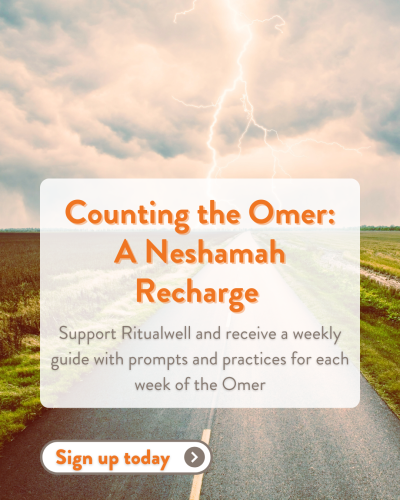The most important aspect of engaging in an expressive practice for the Omer counting period is to give yourself as much compassion (hesed) as possible.
Many years ago, in 1976, I was a student of Rabbi Zalman Schachter-Shalomi at Temple University in the religion department. In a course called “Core Texts of the Kabbalah” I was first introduced to the concept of the sefirot, roughly described as spiritual channels of divine energy that influence the world. For my final project I created a performance piece on the Tree of Life. This is when I first began to make art inspired by deep spiritual concepts and practices. I have continued to study Kabbalah since then.
Fast forward to 2007 and I began a spiritual practice of Counting the Omer, following the inspiration and guidance of Rabbi Yael Levy. For centuries this practice has been used as a time for intense introspection and spiritual growth. The ritual counting spans 49 days, a time equal to the seven biblical weeks of wandering in the desert before receiving the revelations at Mt. Sinai.
After two years of attempts at following this practice and hitting stumbling blocks along the way, I decided, upon sudden inspiration, to paint each day of the Omer instead. In 2009 I completed my first Omer painting. I was given a show of my work at the Borowsky Gallery and there I was approached by a writer who had felt herself stuck in her work. She asked if I would lead her, as I had led myself, on the path of following the 49 days of the Omer and the intentions from the container of the sefirot to create a way, an opening, to her writing. I reproduced photos of the individual days that made up the first Omer painting and gave them to her. Together we crafted her daily practice and since then I have been honored to have guided others in a similar manner. I have continued this practice myself every year. I have also reproduced the paintings into decks of cards each year.
A Glimpse of my Practice
Sometime weeks before the Omer period begins I get an inspiration and begin preparing the surfaces for the paintings I will create. I figure out a size for each panel and what material I will use. I then stain the material a base color, one for each week and for each sefirah.
I begin the Omer counting at night and say a blessing to express the intention, holding those words with me all the next day. It never escapes me that as I begin what may be a challenging journey I always get to begin with Hesed in Hesed, compassionate love held in the container of compassionate love. What better way to exit slavery, look ahead into the unknown and take that first step? I then end each day with a visit to my studio and I paint for that day on the prepared surface waiting for me. The “title” or writing for that day may come to me before I paint or after, and I jot it down on the back of the panel and place it on a wall in my studio.
How to Make this Practice Your Own
The most important aspect of engaging in an expressive practice for the Omer counting period is to give yourself as much compassion (hesed) as possible. If you decide you will write each day, or dance, or create music, recognize that you may not, and that that silence may speak volumes. For me I paint everyday no matter what, and that is also a choice (I do take a break on Shabbat and paint twice on Sunday). I do this, however with a great deal of compassion for myself. Following the Omer cards that I have created is the main tool I use with those who I guide. Simply taking the card of each day with you, looking at it, reading it, being reminded to hold the intention, is a practice that can contribute to moving one on the journey through the desert, of arriving.

D’vorah Horn is a studio artist, an education and professional development consultant, and a therapeutic expressive mentor. Working with children, teens, and adults she acts as a guide to individual expression while exploring techniques in enhancing self realization, communication, and stress reduction. Her current studio and practice space is in Cheltenham, PA. D’vorah holds degrees in philosophy of education and political theory, as well as Masters degrees in human development (MSW), early childhood development, elementary education, and Montessori education (Med). D’vorah has had several recent exhibitions of her paintings and has placed her work in nursing homes, hospitals, hospices, and palliative care centers around the country as an aid in healing. In 2014 D’vorah founded a Fractured Atlas–sponsored non-profit called Mending Spirit, art for healing. Learn more about D'vorah Horn at her website and her Facebook page. Purchase Omer practice cards here.






